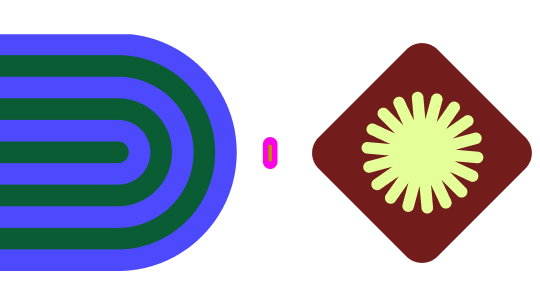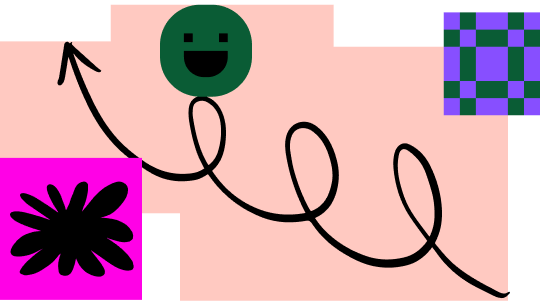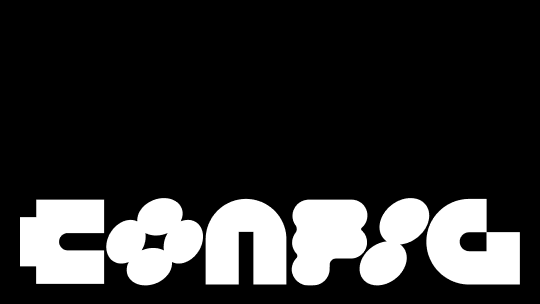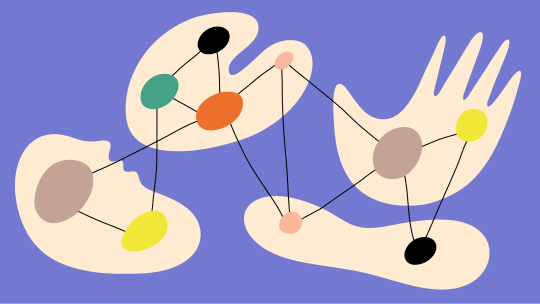Sprint retrospective best practices
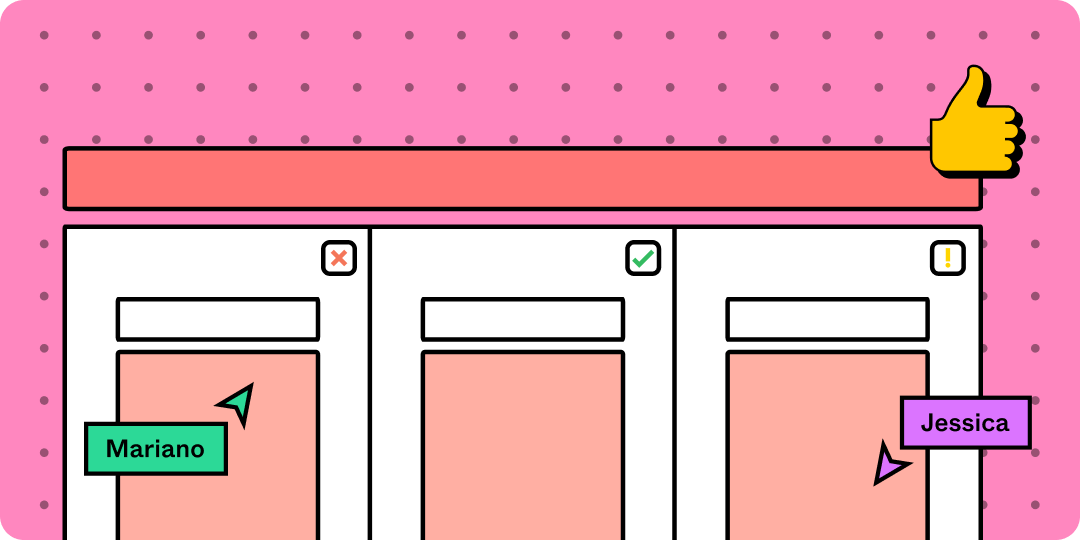
Your design project is off to a strong creative start. Fantastic! But at this point, many design leaders wonder: how can the team keep up the pace, without compromising design standards? Get the answers you need to succeed in your next sprint retrospective with the pro tips below, plus handy FigJam templates.
What is a sprint retrospective?
When your team meets a project milestone, it's time to celebrate (yay!) and hold another team meeting (yay?)—but this is no ordinary team check-in. A sprint retrospective is a moment of truth, when you track progress and brainstorm course corrections together. A well-run sprint retrospective tweaks workflows and strengthens teamwork, helping everyone deliver portfolio-worthy design on time.
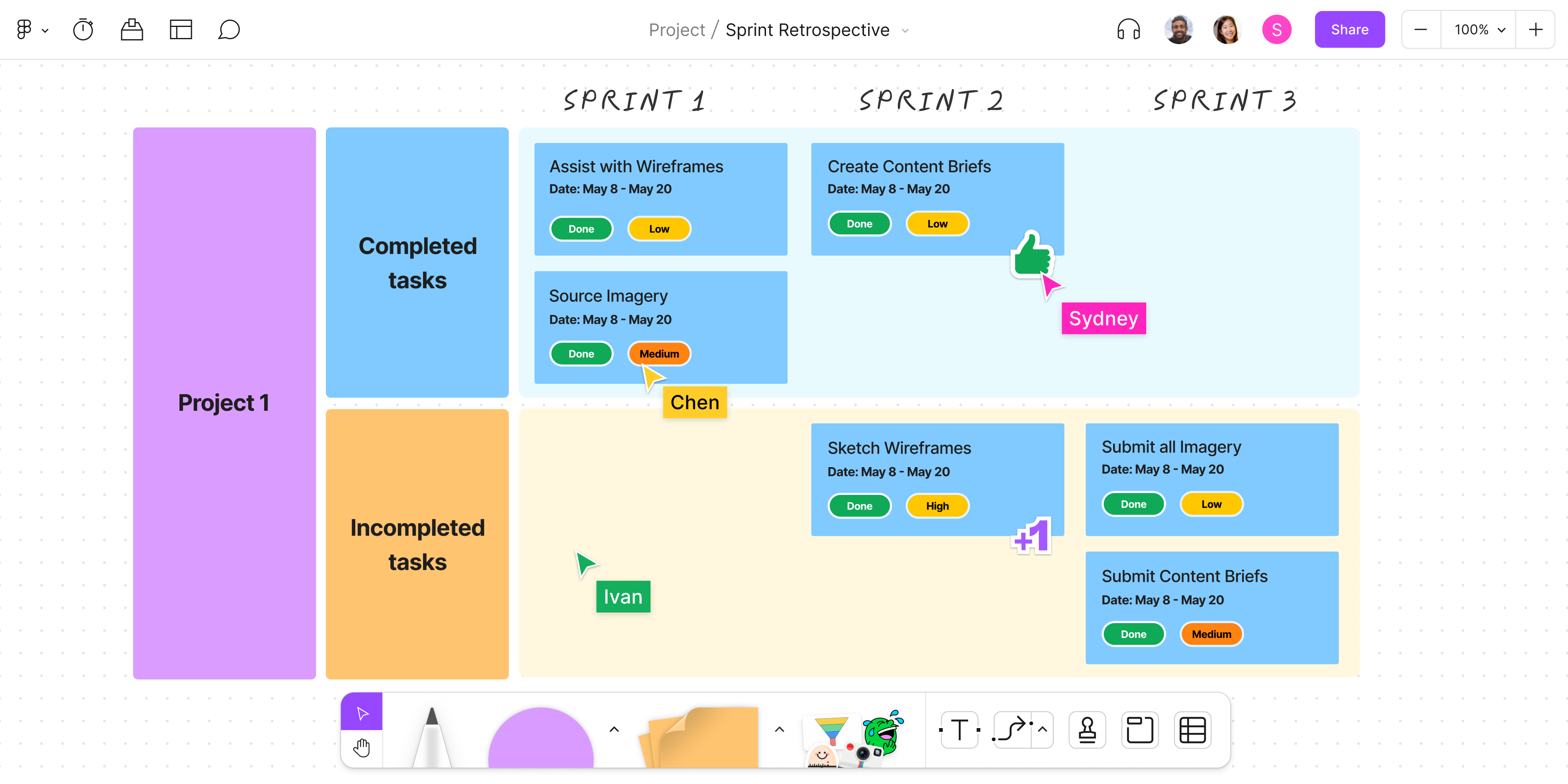
Jumpstart your sprint planning with FigJam
Get started with FigJam's free template today.
What you need to run a successful sprint retrospective
The secret is to engage your whole team the whole time, so that no team members or smart ideas get lost along the way. Especially for teams working remotely, FigJam online collaborative whiteboards make sprint retrospectives creative and constructive from start to finish.
Timebox your sprint retrospective
Let your team know: this won't take all day. With a project retrospective template, you can flag workflow issues and brainstorm solutions in an hour. Experts recommend timeboxing your retrospective to 3 hours max to keep everyone focused and constructive.
Why sprint retrospectives aren't just for developers anymore
Sprint retrospectives seem trendy, but they're the result of a century of workflow improvements. In the 1980s, software developers borrowed techniques long used by Toyota and Ford to build products better and faster—including team sessions to diagram and tweak workflows. In 2001, 17 software developers wrote the Agile Manifesto to capture emerging project management best practices, including retrospectives.
Today no agile team effort is complete without a sprint retrospective to help developers work smarter and faster together. Technology breakthroughs can now be achieved in months instead of years, speeding up production timelines across industries. The Project Management Institute reports that 71% of organizations use agile project management methods. To spur innovation, design leaders are also rapidly adopting agile methods—including sprint retrospectives.
5 steps to run an effective sprint retrospective
The simplest approach is also well-tested: the five-step retrospective framework outlined by agile innovators Esther Derby and Diana Larsen has been refined over 15+ years. Here's how it works.
Step 1: Set the stage for your retrospective.
To run a successful sprint retrospective, think like a coach. You'll establish ground rules, plan a warm-up exercise, and choose prompts to get team discussion up and running. Below are some pointers to get you started.
Establish ground rules
Team leaders might choose to facilitate team discussion themselves, or nominate a team member as facilitator. At the beginning of the retrospective meeting, the facilitator will remind everyone of the retrospective goal: to celebrate team progress and find ways to work together even better on the next sprint.
Find a warm-up exercise
Author and scrum master Corinna Baldauf keeps a running list of retrospective icebreaker ideas that set a positive tone for constructive discussions. Facilitators with large teams can keep it simple, asking each person to describe the sprint in just one word.
Pick simple discussion prompts
Most retrospectives use open-ended prompts to kickstart team discussions to track success and make process improvements. One classic discussion-starter is called Start/Stop/Continue, where the retrospective leader asks team members:
- what new approaches they want to try in the next sprint
- what they want to leave behind in this sprint
- what proven approaches they want to continue in the next sprint.
For design teams, these prompts might seem too tactical to spark creative thinking. So at Stanford University's Institute for Design, design researcher Satu Rekonen codified a creative retrospective approach known as "I like/I wish/I wonder." Reflecting on sprint experiences, team members complete these sentences:
- I like that ….
- I wish that…
- I wonder (or what if) ...
Step 2: Gather data.
After the icebreaker, the facilitator might recap team progress made during the sprint. To make sure no key efforts are overlooked, the facilitator can invite members to add other key sprint achievements and setbacks to a FigJam retrospective template. Capturing sprint reflections gets everyone on the same page, highlighting opportunities to celebrate, learn, and collaborate.
Step 3: Generate insights.
This is where your prompts can jumpstart discussion. Give your team a few minutes to respond to each prompt, then review responses together. What's working well? What could be better? What new ideas might work? Figma diagramming tools can help you highlight any productive patterns (or unproductive antipatterns) that emerge from team input, capturing specific examples from the sprint.
Step 4: Decide what to do differently.
Once you've captured suggestions, flag areas for improvement in the next sprint. For each major issue, what processes, tools, individuals, and interactions could make a difference? Encourage the team to be as specific as possible, so that everyone is on the same page. Teams can use the FigJam brainstorming templates to find solutions, discuss options, and decide which to pursue.
Step 5: Close the retrospective with a plan to move forward.
Once the team has identified a solution to pursue, break it into actionable steps. For each action item, you'll need to set priorities, due dates, team assignments, and expected outcomes. Try to do this now, while the team is united and excited by new ideas. A roles and responsibilities framework adds transparency, so the whole team knows who's doing what when. With a plan to move forward underway, the facilitator can end the retrospective on a positive note.
Dos and don'ts for sprint retrospective facilitators
- Do share the agile "Prime Directive." Agile leader Norm Kerth recommends that teams agree up front that "everyone did the best job they could, given what they knew at the time, their skills and abilities, the resources available, and the situation at hand." Teams anxious about criticism will benefit from this reassurance that the retrospective will be constructive.
- Do engage the whole team. Involving team members as thought partners instead of mere taskers can help teams "move fast without breaking things," producing work of lasting value.
- Don't just nod politely. The facilitator's job is to listen actively, capture what they've heard, and follow up with action items for the team. Team members who believe they can make a difference are happier at work, making their entire organization more productive.
- Don't forget to follow up. Schedule follow-up meetings at regular intervals to help teams apply lessons learned—Google calls this closed-loop learning.
Shortcuts to smart, creative sprint retrospectives with FigJam
For decades, agile teams relied on sticky notes and basic hand-drawn charts to capture ideas in sprint retrospectives. But these physical artifacts aren't always easy to update, share, or understand out of context.
Today, dozens of FigJam retrospective templates help remote and hybrid teams capture feedback, visualize solutions, run polls, set priorities, and track progress across sprints. Our dedicated design community keeps improving these tools, adding dynamic elements, original illustrations, and creative prompts.
With these design tools to support your team's agile thinking, you can produce better designs faster while strengthening your teamwork.
Sources
[1] https://scrumguides.org/docs/scrumguide/v2020/2020-Scrum-Guide-US.pdf
[2] https://www.grin.com/document/1019668
[3] https://hbr.org/2016/04/the-secret-history-of-agile-innovation
[4] https://www.cio.com/article/237027/agile-project-management-a-beginners-guide.html
[5] https://www.fool.com/the-ascent/small-business/project-management/articles/sprint-retrospective/
[6] https://soundcloud.com/tirfpodcast
[7] https://carrcenter.hks.harvard.edu/files/cchr/files/22_voss.pdf
Keep reading
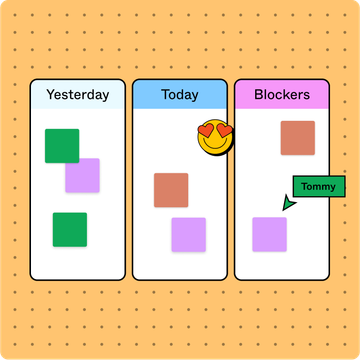
How to run great daily standups
How do you make sure everyone's on board, on task, and on track for a productive day ahead?
Learn more
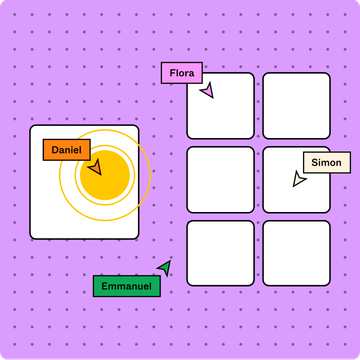
Use diagrams to create and run online workshops
Online workshops are a great way to share information, generate leads, and market your brand.
Learn more

How to create a swimlane diagram
Swimlane diagrams give flowcharts an extra-informative superpower.
Learn more
